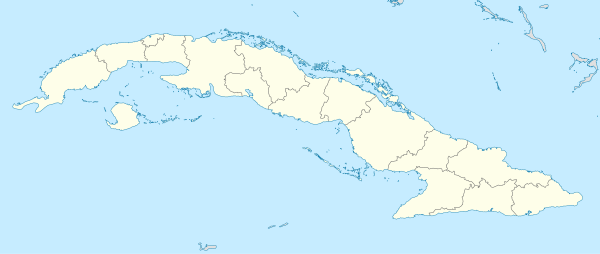Ernst Thälmann Island
Ernst Thälmann Island (German: Ernst-Thälmann-Insel, Spanish: Cayo Ernesto Thaelmann or Cayo Blanco del Sur) is a 15 km (9.3 mi) long and 500 m (1,600 ft) wide Cuban island in the Gulf of Cazones that is named after Ernst Thälmann. During a 1970s state visit to the German Democratic Republic (East Germany), Fidel Castro made a promise that Cuba would donate an island to the East German government,[1] and Cayo Blanco del Sur was renamed in a ceremony during a state visit by Erich Honecker. After the reunification of Germany, a German newspaper tried to visit the island and was told this transfer had only been "symbolic".[2]
 Ernst Thälmann Island | |
| Geography | |
|---|---|
| Location | Gulf of Cazones |
| Area | 7.0 km2 (2.7 sq mi) |
| Administration | |
| Province | Matanzas Province |
| Municipality | Ciénaga de Zapata |
| Demographics | |
| Population | Uninhabited (2016) |
 |
| Ernst Thälmann island, seen off the south-western coast of Cuba |
History
1970s

Until 1972, the island was known as Cayo Blanco del Sur. On the occasion of a state visit in June 1972 by Erich Honecker, Fidel Castro renamed the island in honour of German Communist politician and activist Ernst Thälmann. According to a newspaper article in Neues Deutschland dated 20 June 1972,[1] the Cuban leader announced the renaming of the island, and one of its beaches to Playa "República Democrática Alemana" (English: "German Democratic Republic Beach", German: "DDR-Strand"). East Germany's state television newscast, Aktuelle Kamera, reported on the ceremony and the unveiling of a bust of Ernst Thälmann on 18 August 1972 in the presence of the GDR ambassador, some East German delegates, and approximately 100 Cuban representatives.
In March 1975, the East German government sent singer Frank Schöbel to Cuba to make some music videos, and some footage of the island was shot, which was later included in a documentary emphasising the island as a symbol of GDR-Cuba friendship.[3]
Recent history
In 1998, the island was hit severely by Hurricane Mitch, knocking over the bust of Ernst Thälmann.[2][4]
According to both the Cuban embassy in Germany and the German Foreign Office, the renaming was a "symbolic act": the island was never transferred from Cuba and neither of the German states owned the island at or after reunification.[4]
See also
- Canarreos Archipelago, near the island
- Republic of Molossia, a micronation claiming to be at war with Ernst Thälmann Island
References
- "Die Insel, die Ernst Thälmann's Namen trägt" (PDF). Neues Deutschland (in German). 20 June 1972. Retrieved 31 January 2014.
- Welle (www.dw.com), Deutsche. "Castro's Caribbean island gift to East Germany | DW | 27.11.2016". DW.COM. Retrieved 2019-09-16.
- Gebauer, Matthias (14 February 2001). "Schenkte Castro den Deutschen eine Karibikinsel?" [Did Castro give a Caribbean island to the Germans?]. Spiegel Online (in German). Retrieved 31 January 2014.
- "6 uninhabited and mysterious islands with bizarre pasts".
External links
- Spiegel Online: "Ernst-Thälmann-Insel – DDR unter Palmen" (in German)